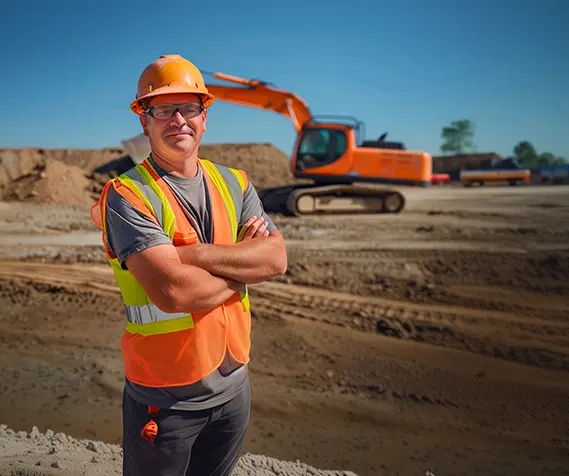Excavation and trenching are among the most hazardous construction operations, presenting risks such as cave-ins, falls, falling loads, hazardous atmospheres, and mobile equipment incidents. However, these risks can be significantly mitigated with the right safety measures, best practices, and proper equipment. This blog outlines essential trench safety best practices to ensure the safety of workers involved in excavation projects.
Understanding Trenching Hazards
Before delving into safety practices, it’s crucial to understand the hazards associated with trenching:
- Cave-ins: The most significant hazard, accounting for a majority of trenching fatalities
- Falls and Falling Loads: Workers or materials can fall into the trench, causing injury
- Hazardous Atmospheres: Trapped gases, lack of oxygen, or the presence of toxic gases can pose serious risks
- Mobile Equipment: Excavation equipment can cause injuries if not operated properly
Regulatory Standards
The Occupational Safety and Health Administration (OSHA) provides comprehensive guidelines for trenching and excavation safety. Adhering to these regulations is essential for maintaining a safe work environment. Key provisions include:
- Protective Systems: Employers must provide adequate protective systems for trenches deeper than 5 feet
- Daily Inspections: Trench sites must be inspected daily by a competent person
- Access and Egress: Safe means of entry and exit must be provided for trenches deeper than 4 feet
- Hazardous Atmospheres: Atmospheric testing is required for trenches deeper than 4 feet where hazardous atmospheres may exist
Best Practices for Trench Safety
1. Conduct a Thorough Site Assessment
Before any excavation begins, conduct a comprehensive site assessment. Identify all potential hazards, such as the proximity of underground utilities, soil type, and environmental conditions. Understanding these factors will guide the implementation of appropriate safety measures.
2. Utilize Protective Systems
To prevent cave-ins, use protective systems such as:
- Shoring: Installing supports to prevent soil movement
- Shielding: Using trench boxes to protect workers within the trench
- Sloping: Cutting back the trench wall at an angle inclined away from the excavation
Choosing the appropriate system depends on the trench depth, soil type, and environmental conditions.
3. Ensure Proper Training and Competence
All workers involved in trenching operations must receive adequate training. This includes understanding the risks, proper use of protective systems, and emergency procedures. A competent person, trained and knowledgeable in trench safety, should be present to oversee the operations and conduct daily inspections.
4. Implement Safe Access and Egress
Trenches deeper than 4 feet require safe means of access and egress. This can include ladders, ramps, or stairs placed within 25 feet of all workers. Ensuring easy and quick access helps prevent delays in case of an emergency.
5. Conduct Regular Inspections
A competent person must inspect trenches daily and after any event that could increase hazards, such as heavy rain or a nearby construction activity. These inspections help identify and mitigate potential risks before they become serious problems.
6. Monitor Hazardous Atmospheres
For trenches deeper than 4 feet, particularly in areas where hazardous atmospheres might exist, conduct atmospheric testing. This includes checking for low oxygen levels, toxic gases, and flammable gases. If a hazardous atmosphere is detected, take immediate corrective actions, such as ventilation or using respiratory protection.
7. Maintain Safe Distances from Equipment
Heavy machinery used for excavation can pose significant risks. Ensure that workers maintain a safe distance from operating equipment and that operators are trained to handle the machinery safely. Use spotters if necessary to guide equipment movement and prevent accidents.
8. Keep Excavated Materials Away from the Trench Edge
Spoil piles and equipment should be kept at least 2 feet away from the trench edge. This prevents materials from falling into the trench and adds an additional layer of protection against cave-ins.
9. Be Prepared for Emergencies
Having an emergency response plan is crucial. This includes procedures for evacuating the trench, first aid measures, and contacting emergency services. All workers should be familiar with the emergency plan and their specific roles in an emergency.
10. Use Proper Signage and Barriers
Use signage and physical barriers to mark the trench area clearly. This helps prevent unauthorized access and alerts workers and the public to the presence of a hazard.
11. Promote a Safety Culture
Fostering a culture of safety within the organization ensures that trench safety becomes a shared responsibility. Encourage workers to report unsafe conditions, participate in safety training, and follow best practices diligently.
12. Regularly Review and Update Safety Protocols
Trench safety protocols should be dynamic, evolving with new insights and technologies. Regularly review and update safety procedures to incorporate the latest best practices and regulatory changes.
Conclusion
Trenching and excavation work pose significant risks, but by adhering to best practices and regulatory standards, these risks can be effectively managed. Conduct thorough site assessments, utilize appropriate protective systems, ensure proper training, and maintain regular inspections to create a safe work environment. By prioritizing trench safety, employers not only protect their workers but also enhance productivity and project success.Request a quote today to have one of our trench specialists assist you in choosing the right solution for your project.

